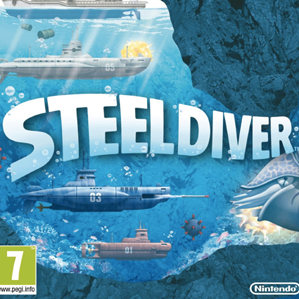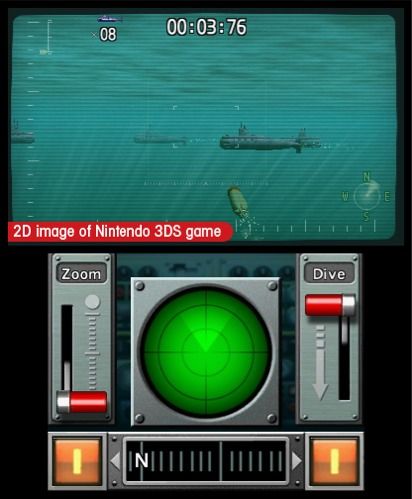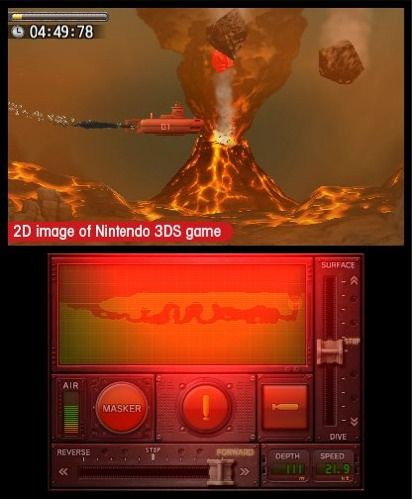Steel Diver is an oddity. Originally developed as a tech-demo for the 3DS, it’s been fleshed out as a full-priced retail game to fit inside Nintendo’s generous launch window, where it joins the trickle of titles emerging for the 3D handheld. Up to a point, you can see Nintendo’s thinking here; more than any other 3DS title we’ve seen so far, this one uses the whole raft of 3DS-specific features, from 3D itself to motion controls. Unfortunately, while that makes it a great tech-demo, it doesn’t actually make it an unmissable game.
Our quick take
At heart, Steel Diver is an interesting game with a handful of strong ideas, but those ideas should have been developed over a longer and more polished campaign. Once, Nintendo could have got away with charging full-price for an experimental but short-lived title, but in the days when Xbox Live Arcade, PSN and the various app stores are offering stronger and equally innovative efforts for much less, Steel Diver simply doesn’t measure up. Until you see it in a bargain bin, leave this one to sink.

Steel Diver - 2.5 / 5
| FOR | AGAINST |
|---|---|
|
|
You can see the game’s roots in its narrative premise - a storyline so spectacularly perfunctory that we won’t even bother to describe it here - and in its lack of atmospheric build-up, cutscenes and other fripperies. The actual gameplay, however, is worth looking at in detail. At first, Steel Diver looks like an aquatic variation of the old-school, horizontally scrolling shoot-em-up - a sort of R-Type meets Crimson Tide. In a submarine, you make your way from one end of the level to the other, squeezing through narrow underground channels, blasting enemy subs with torpedoes and avoiding enemy missiles, depth-charges and natural hazards. You have three different subs to choose from, with one small and maneuverable, one large and heavily armed, and one that sits in-between, and each has its own unique weapons and controls, plus corresponding pros and cons.

The difference lies in the control system. Rather than control the sub directly with the D-Pad, you use the stylus to move sliders and steering columns that alter your sub’s speed and course. With the game set underwater, everything moves at a slowed-down pace, so playing Steel Diver isn’t so much a game of rapid action and reaction as it is about anticipation and getting a feel for how each sub responds. At first it all seems a bit pedestrian - even frustrating - but the more you play the more you find something unique and challenging about the very deliberate style of the game. It’s different to anything you’ve played before.
There are two basic single-player game modes, with time trials through courses without enemy subs involved, and the proper campaign, consisting of a series of missions that escalate in difficulty. The early missions are a bit light on excitement, but later on underwater volcanoes, some elementary puzzles and a handful of boss battles mix things up a bit, and there’s a little more tension and ingenuity at work.
There are other good ideas here, too. Each mission ends with a periscope-targeting mini-game, where you rotate on the spot to turn the periscope and unleash torpedoes on enemy ships (you can use on-screen controls if space is tight). These sections are fun, and substantially more impressive graphically than the basic game. We also like the way the game handles damage, with leaks appearing on the 3DS touchscreen which have to be rubbed to fix them up. Once it gets going, Steel Diver has the makings of a roughly enjoyable little gem.

Sadly, that gem is spoilt by some pretty major flaws. For a start, there are only seven (yes, seven!) actual missions in the campaign. Each takes between 5 and 15 minutes, and two of these are locked at the start and can only be unlocked by repeating the previous five missions with all three subs. This is a bit of a chore, particularly as it also involves our other big whinge; with only the five missions to work in, there’s no room for a proper difficulty curve. Once the first two missions are over, the level of challenge goes from nightmare to medium with no consistency. There are no checkpoints in the missions, just pockets of air where your sub can automatically repair, and there are some hazards in later levels where your sub is just too cumbersome to get out of harm’s way. Annoyingly, you’ll find the worst right at the end of the level. Factor in that you can only move forwards or reverse, not actually turn to move from right to left, and Steel Diver can get extremely aggravating. Only the extremely patient need apply.
To some extent, the brevity is compensated for. Finish the campaign and you can do the lot again in a harder expert mode. What's more, Nintendo throws in a bonus mode which expands the periscope mini-game into a trio of different scenarios and a battleships-style multiplayer strategy mode, but there’s still just not enough game here to make the purchase worthwhile. The presentation isn’t up to Nintendo’s usual high standards, and - despite the odd bit of nice underwater scenery or school of fish - the graphics are a bit on the basic side as well. Only the periscope sections, with their powerful rolling seas, look like what you'd expect from a next-generation handheld. Were this a sub-£5 download game we’d probably say this isn’t a major problem, and suggest that you take a look just to sample the strange and curiously addictive gameplay. Unfortunately, at nearly £30 Steel Diver doesn’t come close to representing good value.
To recap
At heart, Steel Diver is an interesting game with a handful of strong ideas, but those ideas should have been developed over a longer and more polished campaign. Until you see it in a bargain bin, leave this one to sink.
